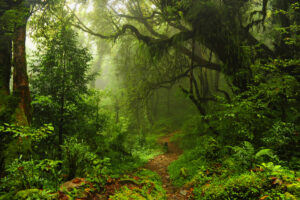Have you watched The Lorax? Yes he may have spoken for the trees, but it turns out, trees can speak for themselves. At the very least, to other trees!
There’s nothing new about different non-human elements of the natural world being able to communicate, as the idea of mycelia (the main body of fungi, as opposed to the more well known bodies of fruiting spores – mushrooms.) having acted as a sort of “old-school” planetary internet system which is still fairly new, serving as a spore of a new type of breed of forestry, ecology and land management.

Most of us tend to ignore the obvious connection between these elements, favoring the micro in place of the macro. The sad reality is, as a society, we are falling prey to the lure of reductionist thinking, considering trees as a commodity instead of an interlinked species of communication.
We assume that we simply replace one tree with another, neglecting the connection. We consider reforestation successful, where large numbers of trees are planted, creating a once diverse interlinked system into a “monocropped farm” of trees.
Suzanne Simard seems to have asserted the importance of not seeing a forest as a mere collection of trees, but as a community of fully independent entities. At her most recent talk at the TED Summit in 2016, she spoke about her three decades of research she performed in Canada’s forests, summing it as “A forest is much more than what you see.”
“Now, we know we all favor our own children, and I wondered, could Douglas fir recognize its own kin, like mama grizzly and her cub? So we set about an experiment, and we grew mother trees with kin and stranger’s seedlings. And it turns out they do recognize their kin. Mother trees colonize their kin with bigger mycorrhizal networks. They send them more carbon below ground.
They even reduce their own root competition to make elbow room for their kids. When mother trees are injured or dying, they also send messages of wisdom on to the next generation of seedlings.
So we’ve used isotope tracing to trace carbon moving from an injured mother tree down her trunk into the mycorrhizal network and into her neighboring seedlings, not only carbon but also defense signals. And these two compounds have increased the resistance of those seedlings to future stresses. So trees talk.” – Simard
As fungi are the key elements of life on Earth, they are clearly misunderstood, in the sheer volume of varieties, how they interact with the entire Eco-system and how important a role they play. There are an estimated 6 million species of fungi, yet only 1.5% have been officially classified. This leaves the study of mycology relatively untapped.
What is there still to discover?
Thank you to Treehugger for an inspiring article!

